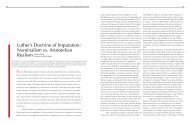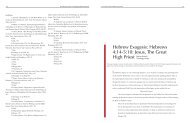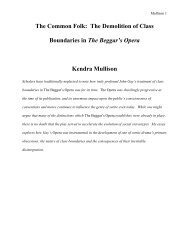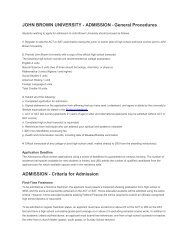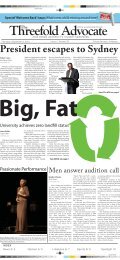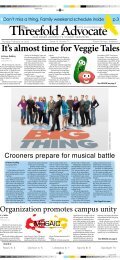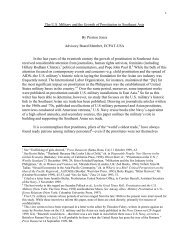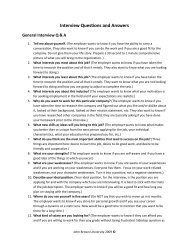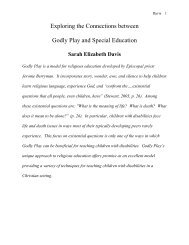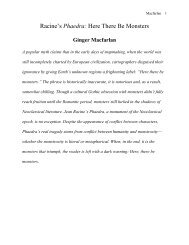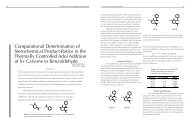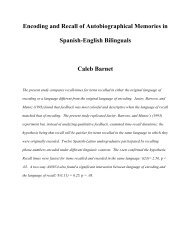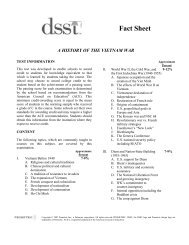2007 - Volume 3 - John Brown University
2007 - Volume 3 - John Brown University
2007 - Volume 3 - John Brown University
You also want an ePaper? Increase the reach of your titles
YUMPU automatically turns print PDFs into web optimized ePapers that Google loves.
Managing Editor<br />
Richard L. Froman, Jr.<br />
<strong>John</strong> <strong>Brown</strong> <strong>University</strong><br />
Board of Peer Reviewers<br />
Juliana Antonio<br />
Matt Aspegren<br />
Jenny Castro<br />
Tommy Craft<br />
Erin Goddard<br />
Larissa Jordan<br />
Suzie Piper<br />
Initial Forays into Psychological Science<br />
<strong>John</strong> <strong>Brown</strong> <strong>University</strong><br />
Copyright © <strong>2007</strong> by each individual author. See author note accompanying each article for contact information to obtain reprint<br />
permission.<br />
Cover art: Human Binomial by Rick Froman ©2006. Used by permission.<br />
Initial Forays into Psychological Science is a publication of the <strong>John</strong> <strong>Brown</strong> <strong>University</strong> Psychology Department and is published online and<br />
freely available for educational fair use. All other uses should be negotiated with the authors.<br />
i
Initial Forays into Psychological Science<br />
<strong>John</strong> <strong>Brown</strong> <strong>University</strong><br />
<strong>Volume</strong> 3, <strong>2007</strong><br />
Contents<br />
Editor’s Corner ……………………………………………………………………………....iii<br />
Instructions for Contributors…………………………………………………………...……..iv<br />
The Influence of Music on Study Habits and Mood and Arousal<br />
Suzie Piper….…...…………………………………………………………………….1<br />
Faith Maturity and the Spiritual Disciplines<br />
Thomas V. Craft..…..……………………………………...……..……………………7<br />
Financial Independence and Self-Confidence among College Students<br />
Matthew Aspegren…..….……………………………………………………..……...11<br />
The Correlation between Exercising and Self-Esteem<br />
Jenny Carolina Castro……………..………………………………………...………..17<br />
Students’ perception of relationship health in most and least committed relationships<br />
Erin Nicole Goddard………………………………………...………...……………..20<br />
ii
Editor’s Corner<br />
The publication of this third volume of Initial Forays into Psychological Science (IFPS) marks<br />
the end of one era and the beginning of a new one. This is the last issue of the journal to be facultyedited.<br />
The fourth volume will be edited by students. The first three volumes have shown that a<br />
student journal is sustainable with extensive faculty control. The next phase of this publication will<br />
test the hypothesis that it is possible to sustain this publication from year to year as a studentcontrolled<br />
publication. These three years have demonstrated that it is possible to sustain a high level<br />
of scholarship in the Research Methods and other classes at JBU by rewarding excellence in<br />
scholarship with publication. It continues to provide students in the Advanced Research Seminar class<br />
with an opportunity to have real life experience in the peer review process and to get students excited<br />
about doing research.<br />
The next volume will also be published in an entirely online format for the first time and students<br />
will be in control of all choices regarding its publication, from the type style to the specific articles<br />
that will be included. I expect that is will continue to be an excellent model of student research for<br />
those in the Research Methods class.<br />
IFPS is also making an impact on the growing culture of scholarship at <strong>John</strong> <strong>Brown</strong> <strong>University</strong>. It<br />
has provided the model for a campus-wide online journal that will begin publication in the Spring of<br />
2008. The new journal will also be student-edited and will invite papers from all disciplines across<br />
JBU. This will provide an excellent outlet for students in the Research Seminar class to publish their<br />
original research while IFPS will continue to provide a place for Research Methods students to<br />
publish their research online and an opportunity for Research Seminar students to simulate the peer<br />
review process. I look forward to seeing how it will develop and what other changes it will inspire in<br />
the coming years.<br />
Richard Froman, Managing Editor of IFPS<br />
The members of the Peer Review Board for the third volume of IFPS. Front row (l to r): Jenny Castro, Suzie Piper, Tommy Craft. Back row<br />
( to r): Erin Goddard, Juliana Antonio, Matthew Aspegren. Not pictured: Larissa Jordan.<br />
iii
Instructions for Contributors<br />
Initial Forays into Psychological Science (IFPS) is a journal which solicits manuscripts<br />
from undergraduate students in psychology classes at <strong>John</strong> <strong>Brown</strong> <strong>University</strong>. Manuscripts<br />
may include research projects conducted for classes, theoretical and review papers written for<br />
classes and empirical or theoretical research conducted as part of a course of independent<br />
study while an undergraduate student at <strong>John</strong> <strong>Brown</strong> <strong>University</strong>.<br />
1. The author must have been a student in a psychology class at <strong>John</strong> <strong>Brown</strong> <strong>University</strong> at<br />
the time the paper was written. The paper must have been read and commented on by a<br />
<strong>John</strong> <strong>Brown</strong> <strong>University</strong> Psychology Department faculty member. Submission of research<br />
to IFPS is not limited to psychology majors but it is limited to students enrolled in<br />
psychology classes at <strong>John</strong> <strong>Brown</strong> <strong>University</strong>.<br />
2. Manuscripts can not be submitted for publication in IFPS while they are being<br />
considered for publication anywhere else.<br />
3. Manuscripts must be formatted in accordance with the manuscript style of the latest<br />
edition of the American Psychological Association (APA) Publication Manual.<br />
Manuscripts must be submitted electronically as an attachment in either Microsoft Word<br />
format or Rich Text Format. Use a 12 point readable font (such as Times New Roman).<br />
4. In the submission e-mail, provide your school e-mail address and a more permanent<br />
summer or post-graduation e-mail address, if one is available.<br />
5. The review process will be completed during the course of the next Fall semester by<br />
the students in the Advanced Research Seminar. The members of the ARS course will act<br />
as reviewers for all of the submitted manuscripts and there will be a student editorial<br />
board appointed by faculty. The reviewers will work in groups so that students’<br />
submissions will not be reviewed by anyone in their group. The review process is likely<br />
to require the author to make some revisions over the course of the Fall semester.<br />
Revisions need to be made and re-submitted in a timely way in order to ensure full<br />
consideration for publication.<br />
6. The IFPS will be made freely available online for use by Research Methods students in<br />
the following semester to be used for assignments in the course. It will be published on<br />
the Psychology Department website at ftp://acadweb.jbu.edu/psychology/IFPS/IFPS.htm<br />
in a format that can be openly accessed by employers, graduate schools, family and<br />
friends, etc.<br />
7. E-mail submissions to Dr. Rick Froman at: rfroman@jbu.edu. Include the following<br />
statement in your e-mail message: “I, [your name] give permission to have the attached<br />
manuscript considered for publication in IFPS. I give permission to the journal (IFPS) to<br />
publish my work and sell it to university students at cost. I understand that I will retain<br />
the copyright and the right to submit my manuscript to any other publication I desire.”<br />
iv
The Influence of Music on Study Habits<br />
and Mood and Arousal<br />
Suzie Piper<br />
1 Testing the influence of calming music upon choice to listen to that music while studying<br />
was obtained through a 14-question, online survey administered to 79, randomly selected<br />
<strong>John</strong> <strong>Brown</strong> <strong>University</strong> students. The 29 participants, overall, listened to more calming<br />
music while studying and as a means by which to either change their mood or match their<br />
mood while studying. A t-test assuming equal variances was conducted on the Likert scale<br />
questions, and the results showed no significant differences between groups (male and<br />
female). In regards to within-group findings, the mean averages showed that females tended<br />
to either rate their music as calming or aggressive, while males were more ambiguous in<br />
their ratings of music as either calming or aggressive.<br />
Music can influence many areas of our lives. One of the most studied ideas of music is<br />
the ‘Mozart Effect’. The Mozart Effect is the claim that people perform better on tests of<br />
spatial abilities after listening to music composed by Mozart (Thompson, et. al., 2001). One<br />
unique study of the Mozart Effect was conducted by William Forde Thompson, E. Glenn<br />
Schellenberg, and Gabriella Husain (2001), who studied the Mozart Effect in relationship to<br />
mood and arousal in three groups. One group was exposed to a pleasant piece of piano music<br />
which was supposed to put participants of that group in a positive mood. A second group was<br />
exposed to a melancholy or sad piece of instrumental music assumed to put participants of<br />
that group in a negative mood, and one group was left in silence. Thompson et. al. found a<br />
significant difference from pretest to posttest in the group exposed to the pleasant, positively<br />
arousing music, while the other groups showed no significant difference from pretest to<br />
posttest. The conclusion of their results led them to assume that participants’ performances<br />
from pretest to posttest were significantly different because of the level of arousal and mood.<br />
In correlation with the study conducted by Thompson and et. al., Robert H. Woody and<br />
Kimberly J. Burns conducted re- search where, during the course of the study, participants<br />
were asked why they chose the music to which they listened. The questions were asked in<br />
survey form, and the majority of participants replied with answers that related to mood,<br />
saying that they chose their music as a means by which to either change their present mood<br />
or to match their present mood (2001).<br />
Based on my study of previous research, I decided to base my study on the idea that<br />
students will be more likely to listen to music while studying if they find the music positively<br />
arousing, based upon how calming or aggressive they rate their music. My definition and<br />
way for measuring whether music is positively arousing is: the more calming a participant<br />
rates his or her music, the more likely that participant will be to listen to that music while<br />
studying. I expect that students who rate their music as more calming will be more likely to<br />
1 Suzie Piper, Department of Psychology, <strong>John</strong> <strong>Brown</strong> <strong>University</strong>.<br />
Correspondence concerning this study should be addressed to Suzie Piper c/o Psychology Department, <strong>John</strong><br />
<strong>Brown</strong> <strong>University</strong>, Siloam Springs, AR 72761. E-mail may be sent to pipers@jbu.edu.<br />
1
Suzie Piper<br />
listen to music while studying, and I also expect that females will listen to more calming<br />
music while studying than males.<br />
METHOD<br />
Participants<br />
The data used for this study are taken from a random sample of students from <strong>John</strong><br />
<strong>Brown</strong> <strong>University</strong>, a small, nondenominational, private school in Siloam Springs, Arkansas.<br />
The students were chosen randomly through the <strong>University</strong> emailing system. There were 79<br />
randomly chosen students, and 29 of those students chose to participate. There were 16 male<br />
participants and 13 female participants. Students were asked to participate only if they were<br />
18 years or older.<br />
Materials<br />
A random email list was acquired and used. Participants were asked to fill out a 14<br />
question survey which consisted of multiple choice questions, open-ended questions,<br />
true/false questions, and Likert scale questions (see Appendix). Ratings of calmness or<br />
aggressiveness were measured on Likert scales such as the following: “Please rate the<br />
following on the scale below: how calming do you rate the music to which you listen?” There<br />
were similar questions for ratings of aggressiveness in music listened to in general and for<br />
ratings of calmness and aggressiveness of music listened to while studying.<br />
Some true/false questions measured how frequently participants listened to music often<br />
in general, and other true/false questions measured whether participants listened to music<br />
studying. Open-ended questions were measurements of what type of music students listened<br />
to in general, how often music was listened to in general, and why participants chose either to<br />
listen to or not to listen to music while studying.<br />
There were only two multiple choice questions, on of which asked participants with<br />
what kind of homework or schoolwork do they normally listen to music. The choices<br />
consisted of the following: a.) reading assignments; b.) worksheet or similar assignments; c.)<br />
writing assignments; d.) other; e.) none. The other multiple choice question asked<br />
participants to what kind of music do they listen while studying for classes, and the choices<br />
are as follows: a.) rock or rap music; b.) country music; c.) instrumental or piano music; d.)<br />
other.<br />
Procedure<br />
An email containing an informed consent section, a brief statement about the reason for<br />
sending the email, what was asked and expected of each recipient, and a link to the survey<br />
was sent to the randomly selected students. The online survey contained the questions,<br />
another section of informed consent, brief, clear instructions, and a thank-you to anyone who<br />
participated.<br />
RESULTS<br />
The sample was divided into two groups: male and female. A t-test assuming equal<br />
variances was conducted on the Likert style questions. Between groups, no significant results<br />
were found. In ratings of calming music listened to in general, there was no significant<br />
difference between groups, t(27) = 2.05, p = 0.24. Ratings of aggressive music listened to in<br />
general was also insignificant with, t(27) = 2.05, p = 0.16. There was no significant<br />
2
Music and Mood<br />
difference between groups in how often participants listened to music while studying, t(27) =<br />
2.05, p > .05. When asked to rate how calming the music listened to while studying was,<br />
there was no significant difference between groups, t(25) = 2.06, p > .05. In rating how<br />
aggressive their music was while studying, there was no significant difference between<br />
groups with, t(25) = 2.06, p >.05.<br />
In regards to within-group results for males, male participants tended to be more<br />
ambiguous with their answers on how calming (M = 4.38) and aggressive (M = 4.19) was the<br />
music to which they listened in general. When asked to rate how calming (M = 5.57) and<br />
aggressive (M = 3.14) was the music to which they listened while studying, males became<br />
less ambiguous in their ratings and began to rate the music to which they listened while<br />
studying as either calming or aggressive.<br />
In regards to within-group results for females, female participants tended to rate the<br />
music to which they listened in general as either calming (M = 5) or aggressive (M = 3.15).<br />
When asked to rate how calming (M = 5.38) and aggressive (M = 2.46) was the music to<br />
which they listened while studying, females remained consistent in rating their music as<br />
either calming or aggressive.<br />
When participants were asked to what kind of music do they normally listen in general<br />
and while studying, in an averaging of scores, the majority stated Contemporary Christian<br />
music or Christian worship music. The majority of males said that they listened to music<br />
while studying when doing worksheet or similar assignments or they did not listen to music<br />
at all. The majority of female participants said that they listened to music while studying<br />
either with worksheet or similar assignments or writing assignments. When answering the<br />
question of why they chose to listen to music while studying, the majority of both genders<br />
replied with answers pertaining to mood and how music helps to either change their mood or<br />
match their mood.<br />
DISCUSSION<br />
The In regards to differences between groups, there was no significant difference found<br />
in any of the statistical analyses. Overall, participants did tend to listen to more calming<br />
music while studying, but the difference was not significant. In addition, females did listen to<br />
more calming music while studying, but males also tended to listen to more calming music,<br />
and the difference between groups was not significant. However, some of these results could<br />
have been due to several things. First, the sample may not have been large enough, and it<br />
was not equal. Second, the survey questions may not have been relevant or valid enough for<br />
what was being tested. Third, not all participants answered all of the questions. There were<br />
two male participants who chose not to answer the questions for rating how calming and<br />
aggressive they found the music to which they listened while studying. Fourth, because I did<br />
not have control over how participants chose the music to which they listened while<br />
studying, there were most likely varied opinions or ideas about what type of music is calming<br />
or aggressive in regards to style of music and personal opinion.<br />
When studying, it seems that individuals (in this study) of both sexes tend to listen to<br />
music which they found more calming. Most participants related their choice of music while<br />
studying to how it would affect their mood, either to change it or match it. These results were<br />
similar to the results found by Woody and Burns and Thompson et. al. Mood does seem to<br />
play a factor in how individuals choose their music (2001). However, since my study<br />
included a survey, it may not be applicable to all areas of the previous research which used<br />
3
Suzie Piper<br />
actual experiments. In addition, my definition for positive arousal may not be entirely<br />
applicable to previous research, but it is similar to the Thompson and et. al. study which used<br />
music supposed to create either good mood or negative mood as a means by which to<br />
determine levels of arousal (2001).<br />
Further research should attempt to use a larger, more equal sample, and, if a survey is<br />
still used, the survey used in this study should be formatted for content and validity. Using<br />
actual experimentation would probably be best for maintaining some level of control over<br />
what style of music is heard while studying and for maintaining some level of control over<br />
positively arousing and negatively arousing music heard while studying. Any further research<br />
should focus on mood and how it affects what music is listened to while studying as well as<br />
its effect upon what is being studied.<br />
REFERENCES<br />
Thompson, W. F., Schellenberg, E.G., & Husain, G. (2001). Arousal, mood, & the Mozart Effect.<br />
Psychological Science, 12.<br />
Woody, R. H., & Burns, K. J. (2001). Predicting music appreciation with past emotional responses to music.<br />
Journal of Research in Music Education, 49, 57, 14.<br />
4
Music and Mood<br />
APPENDIX<br />
This survey is part of a student research project being conducted this semester to study music<br />
influence. If you choose to participate in this study, your answers will be used, but all<br />
personal information will be kept strictly confidential. You may omit any item that you do<br />
not wish to answer, and you may stop participating at any point while filling out the<br />
questionnaire. Try to complete the survey in one sitting if at all possible. If you have any<br />
questions, you may contact me at: pipers@jbu.edu. Please return the completed survey by<br />
April 13, 2005. Thank you for your participation.<br />
Circle one:<br />
M / F<br />
1. T / F I listen to music often<br />
2. How of often do you listen to music?<br />
3. I usually listen to:<br />
a. rock or rap music<br />
b. country music<br />
c. instrumental or piano music<br />
d. other<br />
4. On a scale of one to five, how calming would you rate the music you listen to most?<br />
1 2 3 4 5<br />
5. On a scale of one to five, how aggressive would you rate the music you listen to most?<br />
1 2 3 4 5<br />
6. T / F When studying for classes, I listen to music<br />
7. How often do you listen to music while studying?<br />
5
Suzie Piper<br />
8. With what class material do you usually listen to music?<br />
a. reading assignments<br />
b. worksheet or similar assignments<br />
c. writing assignments<br />
d. other<br />
e. none<br />
9. When studying for classes, I listen to:<br />
a. rock or rap music<br />
b. country music<br />
c. instrumental or piano music<br />
d. other<br />
10. On a scale of one to five, how calming would you rate the music you listen to while<br />
studying?<br />
1 2 3 4 5<br />
11. On a scale of one to five, how aggressive would you rate the music you listen to while<br />
studying?<br />
1 2 3 4 5<br />
12. If you listen to music while studying, why do you like to listen to music while studying?<br />
13. If you do not listen to music while studying, why do you not like to listen to music while<br />
studying?<br />
6
Faith Maturity and the Spiritual Disciplines<br />
Thomas V. Craft<br />
2This study is testing for a correlation between the spiritual disciplines and faith<br />
maturity. I expect that we will see a positive correlation between the spiritual<br />
disciplines, such as prayer, study, meditation, etc., and faith maturity. My partners in<br />
research were 27 randomly selected students of <strong>John</strong> <strong>Brown</strong> <strong>University</strong> who took the<br />
Faith Development Scale and a spiritual practices survey. It showed that the over all<br />
correlation between scores on the FDS and the incidence of the spiritual disciplines was<br />
insignificant. Although there was no correlation found between spiritual maturity and<br />
the spiritual disciplines, there were enough extraneous variables to account for the lack<br />
of significance.<br />
At <strong>John</strong> <strong>Brown</strong> <strong>University</strong>, students are constantly being told that if we practice the<br />
Spiritual disciplines then we will continue in the maturation of our faith. It is in the<br />
books we are asked to read, it is in our Bibles, it is in the lectures and chapel services.<br />
We are constantly told this, but who has scientifically studied it? It is understood that<br />
religious practices don’t in and of themselves breed faith maturity. Only God can<br />
produce that within us. But, this is not an attempt to prove causation, but merely to<br />
show a correlation. Faith maturity by definition is the level of maturity that we possess<br />
in the faith realm of our lives. Spiritual Practices, on the other hand are those practices<br />
that we participate in, such as prayer, Scripture reading, etc, that are said to develop our<br />
Christian faith.<br />
There actually has not been very much research on this topic. There have been<br />
two studies, that I have found that are relevant but are not studying this exact correlation.<br />
Michalec (2005) conducted a study to try and gain the ability to predict religious<br />
practices by determining the connection between attachment, religious faith<br />
development, and religious practices. Michalec concluded that having a “religious<br />
framework” moves an individual to conduct spiritual practices. Furthermore, Sanders<br />
(1998) conducted a study in which he tested how exploring one’s faith led to faith<br />
development. This study is particularly applicable to the current study because<br />
exploring one’s faith must in turn deal with at least some of the disciplines of that faith.<br />
His results showed that individuals who did explore their faith were more likely to be<br />
more mature than those who did not. From these results, I expect that we will see a<br />
positive correlation between the spiritual disciplines, such as prayer, study, meditation,<br />
etc., and faith maturity.<br />
Thomas V. Craft, Department of Psychology, <strong>John</strong> <strong>Brown</strong> <strong>University</strong>.<br />
Support for this research was provided by <strong>John</strong> <strong>Brown</strong> <strong>University</strong>. I am grateful to Rick Froman and Rebecca White for all<br />
their assistance in preparing the paper and helping with the statistical analysis.<br />
Correspondence concerning this article should be addressed to Thomas Craft, 2000 W. <strong>University</strong> Street Box 2169, Siloam<br />
Springs, Arkansas, 72761. Email: CraftTV@jbu.edu.<br />
7
Thomas V. Craft<br />
METHOD<br />
Participants<br />
My partners in research were a random selection of <strong>John</strong> <strong>Brown</strong> <strong>University</strong> students<br />
to me by my supervisor, Dr. Rick Froman. The only qualifying characteristic was that<br />
they were students at <strong>John</strong> <strong>Brown</strong> <strong>University</strong>, a four year Christian university. I<br />
received a list of 104 possible participants 27 of which participated.<br />
Materials<br />
The first survey, The Faith Development Scale (FDS) was originally designed by<br />
Gary Leak to measure the differences in faith development between entering freshmen<br />
and graduating senior college students but I thought it served my purpose well. It<br />
consists of eight dichotomous choice items and asks the participant to choose one or the<br />
other. The second part of the survey I designed and it merely asked for the regular<br />
incidence of Spiritual disciplines the participant took part in over a given period of time.<br />
The spiritual disciplines are the acts of participating in any of the following: meditation,<br />
prayer, fasting, Bible study, simplistic living, times of extended silence for reflection,<br />
selflessness, serving others, confession, going to church, seeking Christian guidance, and<br />
thankfulness toward God and others. The disciplines are taken from Richard J. Foster’s<br />
book “Celebration of Discipline”. A copy of both surveys can be seen at the following<br />
link: http://acadweb.jbu.edu/psy2393/Surveys/Old%20surveys/Craft.htm.<br />
Procedure<br />
I put the survey into web page format that participants filled out online. I then sent<br />
out an e-mail requesting that they participate in the survey and included the link in the e-<br />
mail. They went to the web page, filled out the survey, then clicked the submit button<br />
and in so doing they acknowledged consent. The results were then gathered and<br />
statistically analyzed for significant results.<br />
RESULTS<br />
The data was analyzed using a Pearson R correlation. It showed that the over all<br />
correlation, r(25)=.096, p=.63, between scores on the FDS and the incidence of the<br />
spiritual disciplines was insignificant (see Fig. 1). The results were then broken down to<br />
see if particular questions were correlated. It was found that there was a significant<br />
correlation between spiritual maturity as defined by having one’s own beliefs apart from<br />
the individual‘s church teachings and thankfulness toward God, r(25)=.46, p=.02,<br />
Church attendance, r(25)=.57, p
Faith Maturity and Disciplines<br />
60<br />
50<br />
Spiritual Practices<br />
40<br />
30<br />
20<br />
10<br />
0<br />
0 2 4 6 8 10 12 14 16 18<br />
Spiritual Maturity<br />
Figure 1. Correlation Between Faith Maturity and Spiritual Practices<br />
DISCUSSION<br />
In spite of the fact that I hypothesized that there would be a correlation between<br />
faith maturity and spiritual disciplines, I found none. Although I was drawing out two of<br />
Michalec’s (2005) variables, the correlation was not supported by itself. Neither did I<br />
support Sander’s (1998) research because the spiritual disciplines as an example of<br />
exploring one’s faith did not lead to faith maturity.<br />
I did find some interesting correlations once I analyzed the correlation between the<br />
individual questions in each survey. When I did this I found that there was a significant<br />
correlation between spiritual maturity as defined by having one’s own beliefs apart from<br />
the individual’s church teachings and thankfulness to God, church attendance, frequency<br />
of Bible study, and daily prayer. I thought this was quite interesting because it seems the<br />
more you practiced the basic disciplines the more likely you are to form your own<br />
beliefs.<br />
I also found a significant correlation between spiritual maturity as defined by<br />
developing personal faith apart from that of parents and seeking guidance from others,<br />
serving others, Bible study, and prayer. I thought that this was incredibly interesting for<br />
somewhat of the same reason, as one gets more involved in these disciplines you are<br />
more likely to develop your own beliefs apart from parents. The most conclusive things<br />
that my study did show then was that the more an individual prays and studies Scripture,<br />
the more likely they are to develop their own beliefs apart from both parents and church.<br />
There were a few problems that I perceived in the study. First of all, I did not come<br />
up with a working definition of faith maturity before I began. Because of that, the FDS<br />
that I used was not particularly applicable to what I was studying. The FDS is more for<br />
studying faith development in general, and I was studying specifically Christian faith<br />
9
Thomas V. Craft<br />
development. This created problems in that the FDS valued breaking away and<br />
individualizing faith apart from tradition which in a Christian sense does not necessarily<br />
mean that one is maturing in their faith. For future research, I would use the passages in<br />
Scripture that specifically talk about spiritual maturity to first of all define it and second<br />
of all to come up with a survey that would test for it.<br />
I also think that it would be important to see if there is a specific difference between<br />
the age and sex of participants and the spiritual practices that specifically helped them<br />
develop maturity. In the future this should be taken into account and age and sex should<br />
be a question in the survey for that purpose. In order to do this, a bigger sample size<br />
would definitely be needed in order to come up with significant correlations.<br />
Although there was no correlation found between spiritual maturity and the spiritual<br />
disciplines, there were enough extraneous variables to account for that. This study was<br />
not conclusive and needs to be followed by more research emphasizing age/sex<br />
differences, specific Christian faith, and a spiritual maturity survey that reflects the<br />
definition Christians are given in the Bible.<br />
REFERENCES<br />
Michalec, David F. (2005). Attachment dimensions, faith development, and religious practices: An exploration among nontraditional<br />
college students. Dissertation Abstracts International: Section B: The Sciences & Engineering, 65, 4874.<br />
Sanders, Jeffrey L. (1998). Religious ego identity and its relationship to faith maturity. Journal of Psychology: Interdisciplinary &<br />
Applied, 132(6), 653-658.<br />
Foster, Richard J. (1998). Celebration of Discipline. Hodder and Stoughton Religious.<br />
10
Financial Independence and Self-Confidence<br />
among College Students<br />
Matthew Aspegren<br />
3 This study investigates the relationship between the financial dependence of college<br />
students and their respective self-esteems. Takagishi and Curtis (1999) found that there<br />
was a positive correlation between people with a series of characteristics and their<br />
psychological functioning and well-beings. One of the characteristics in this study was<br />
financial independence. In this study the financial dependence of college students is<br />
correlated with self-esteem. Forty-nine students from <strong>John</strong> <strong>Brown</strong> <strong>University</strong> were<br />
asked to take an online survey concerning their financial dependence levels and selfesteems.<br />
There was no significant correlation found between the two, and, therefore, no<br />
support to the hypothesis that there would be a negative relationship between financial<br />
dependence and self-esteem among college students.<br />
The idea of the American college student cannot be stereotyped. Some students<br />
work full time to support themselves through school, while others do not see<br />
employment, or a bill, until after graduation. The relative level of familial dependence<br />
defines the learning curve of life for many American college students. A slower learning<br />
curve usually means less responsibility and fewer significant life experiences, while the<br />
quicker one brings reality sooner than possibly expected.<br />
Research by Takagishi and Curtis (1999) found a correlation between the wellbeing<br />
and psychological functioning of young adults and a multitude of characteristics.<br />
Within this particular study there were six factors considered and found to have a<br />
positive correlation with well-being and psychological functioning. One of the<br />
characteristics of the college students being studied was financial independence from<br />
their families.<br />
The study described above showed a correlation between financial independence<br />
and well-being and psychological functioning, but not without a considerable amount of<br />
other factors. This study attempts to find positive correlation between financial<br />
independence and self-confidence where other variables are limited. I hypothesize that<br />
this study will find a positive correlation between the self-esteem of college students and<br />
their relative levels of financial independence.<br />
3 My name is Matt Aspegren and I am a student at <strong>John</strong> <strong>Brown</strong> <strong>University</strong> in the Department of<br />
Psychology in Siloam Springs, AR. I can be reached by email at aspegrenm@jbu.edu.<br />
I would like to thank the Department of Psychology and Rick Froman at <strong>John</strong> <strong>Brown</strong> <strong>University</strong> for<br />
the support for this research.<br />
11
Matthew Aspegren<br />
METHOD<br />
Participants<br />
The data used for this study are taken from a random sample of over 1,000<br />
students attending <strong>John</strong> <strong>Brown</strong> <strong>University</strong> in the spring of 2006. Both males and<br />
females of all classifications were surveyed. The survey was taken by those who were<br />
randomly selected to receive, and chose to participate in, the survey. Those who<br />
participated were split almost evenly male and female, with ages ranging from 18-23.<br />
Financial demographics were not questioned, only to what extent students were<br />
financially supported. No extra credit, monetary, or other reward was given to those<br />
who completed the survey. A power analysis showed that for this study to show<br />
significant results (significance level .05) with a desired power level of .8 and a<br />
correlation coefficient under that alternative hypothesis of .4 there must be at least 48<br />
participants. Random E-mails were sent out to 100 <strong>John</strong> <strong>Brown</strong> <strong>University</strong> students and<br />
49 students responded.<br />
Materials<br />
Participants received access to a self-developed online survey (see Appendix). A<br />
list of random e-mail addresses of <strong>John</strong> <strong>Brown</strong> <strong>University</strong> students was used to send 200<br />
of its students a link to the survey and its instructions.<br />
This survey asked two series of questions to participants on self-esteem and<br />
financial dependence levels respectively. The first part of the survey, focusing on selfesteem,<br />
asked questions about what participants think about themselves, how they would<br />
react in certain situations, and how they interact with other people in relation to their<br />
opinions and their perspectives of others’.<br />
The questions on financial independence asked the participants how much of their<br />
accumulative college expenses are provided for by their families and how much is paid<br />
for by some other personal contact.<br />
Procedure<br />
Surveys were offered online. Surveys instructed participants to answer all the<br />
questions as honestly as they could. To avoid response sets, questions were not<br />
consistently worded positively or negatively and there were multiple possible<br />
arrangements of questions that participants could receive.<br />
Initially the randomly selected participants received a link to the survey as well as<br />
preliminary information about the survey. Participants were not told the hypothesis of<br />
the research because this could affect their answers. On the online survey, the<br />
participants pressing the submit button agreed with the confidentiality of the survey. The<br />
surveys were submitted anonymously and the participants were informed that they could<br />
stop at any time or skip any questions they did not feel comfortable answering.<br />
RESULTS<br />
A series of correlations were done to see if self-esteem levels and financial<br />
dependence corresponded in any way. The first correlation done was that of the selfesteems<br />
of the entire sample and their family financial support. There was no significant<br />
correlation found, r=.035, p>.05. There was also no significant correlation found for the<br />
self-esteem of the entire sample and other sources of financial dependence (r=-.036) or<br />
12
Financial Independence and Self-confidence<br />
self-esteem and total financial dependence, r=.002, p>.05. There was no significant<br />
correlation found between age and self-esteem, class and self-esteem, or sex and selfesteem.<br />
The correlation between family given financial support and self-esteem among<br />
males was found to be .213. The correlation between family given support and selfesteem<br />
among females was -.116. These were not found to be significant. A correlation<br />
between familial financial support and self-esteem was done for each class and no<br />
significant affect was found: Freshman r=.123, Sophomore r=.106, Junior r=.130,<br />
Senior r=.152. A negative correlation of .881 was found between the average scores in<br />
self-esteem and the average scores of familial financial dependence by class.<br />
DISCUSSION<br />
The -.881 correlation found between the averages of self-esteem and the averages of<br />
financial support seem to support this study’s hypothesis, but when the average selfesteem<br />
numbers are looked at, it is found that these results do not mean much. The four<br />
self-esteem averages are all within one standard deviation of each other and do not stray<br />
from the mean by more than 1.13 points on a scale with a standard deviation of 2.52.<br />
The small differences in self-esteem averages happen to switch sides of the mean at the<br />
same times that, and in the opposite direction than, average familial support does relative<br />
to class. This and the insignificant results of each class’s self -esteem/financial<br />
dependence correlation support the nullification of the original hypothesis. The study<br />
resulted in no significant support of the original hypothesis.<br />
However, with a few assumptions made, the insignificance of this result may lead to<br />
something significant. If we assume that generally those with higher self-esteems are<br />
more likely to be successful, and that success is at least partly a function of financial<br />
progress, then this study may support the idea that financial support during college is not<br />
a major contributing factor in financial successes later in life. This refutes the idea often<br />
toted by politicians that the poor stay poor, while the wealthy only get wealthier, and<br />
consequently evens the playing field among those in school.<br />
Furthermore, a study by Rosenberg and Pearlin (cited in Wiltfang, 1990) found a<br />
negative correlation between neighborhoods with high unemployment rates and<br />
adolescent self-esteem. If we assume that those not supported by their families are more<br />
likely to come from neighborhoods with high unemployment rates (and likely lower<br />
income levels), and there is not any significant difference between financial support and<br />
self-esteem of the students of <strong>John</strong> <strong>Brown</strong> <strong>University</strong>, we can assume that an<br />
environment of education raises the self-esteem level of people formerly living in those<br />
neighborhoods. The support of the null hypothesis in this study further supports the<br />
helpfulness of education for America’s youth; especially those coming from low income<br />
areas. There is no proof that the students not supported by family in this study are from<br />
areas of little income, but logic would follow that they generally come from areas of<br />
littler income than those who receive more financial support.<br />
Future research should focus on the self-esteems of those in low income<br />
neighborhoods, and if those who go to four year institutions have a significant increase<br />
in self-esteem and if those who stay in those neighborhoods do not. Future research<br />
should also address the validity of the idea that self-esteem precedes success, and if that<br />
success is financial. Longitudinal study of adolescents through college age and into<br />
financial dependence is suggested for future study as well. The success of people is<br />
13
Matthew Aspegren<br />
dependent on a number of characteristics, but the longitudinal study of success and selfesteem<br />
should be considered.<br />
This study has not supported the hypothesis it set out to support, but its results<br />
should be helpful to future studies in the financial capabilities of the American college<br />
student. Often considered the future of this country, if college students are not studied to<br />
see what makes them successful, how else can we (as a society) attempt to understand,<br />
predict and support the success of this country’s future?<br />
REFERENCES<br />
Takagishi & Curtis, S. (1999). An examination of young adults as they separate from their<br />
parents: A six-factor approach. Dissertation Abstracts International.<br />
http://search.epnet.com/login.aspx?direct=true&db=psyh&an=1999-95020-273<br />
Wiltfang, G. & Scarbecz M. (1990). Adolescents’ Self-Esteem: Another Look. Social Psychology<br />
Quarterly, 53, 174-183.<br />
http://www.jstor.org/view/01902725/dm993241/99p0535l/0?currentResult=01902725%2bdm993241<br />
%2b99p0535l%2b0%2cFF07&searchUrl=http%3A%2F%2Fwww.jstor.org%2Fsearch%2FBasicResu<br />
lts%3Fhp%3D25%26si%3D1%26Query%3Dsuccess%2Bself-esteem<br />
14
Financial Independence and Self-confidence<br />
APPENDIX<br />
1. When you make a mistake do you tend to…<br />
a. Feel ashamed and embarrassed.<br />
b. Who me? I never make mistakes. But if I did make one, I would immedieately<br />
correct it and hope no one was watching.<br />
c. I have no fear owning up to it in public, and I am open to receiving help from<br />
others in fixing it.<br />
2. On average, when you look at yourself in the mirror what do you believe you see?<br />
a. Someone who is attractive and confident.<br />
b. Someone who is average and often unsure about what to do in life.<br />
c. Someone who is ugly and insecure.<br />
3. When you are dealing with a problem in your life what do you tend to do?<br />
a. Blame everyone or anything that I think caused the situation. It’s rarely my fault.<br />
b. I complain and vent to anyone willing to listen but rarely address my personal<br />
responsibility for the issue.<br />
c. Take responsibility for my thoughts, words, and actions because if I take<br />
ownership I am not a victim to the situation.<br />
4. If my wants and needs are different from those of others I am likely to…<br />
a. Give up and give in. I'd accommodate.<br />
b. Say, "My way or the highway!" I argue until I get my way<br />
c. Create a win/win<br />
5. When you think about the greater purpose of your life what do you tend to think?<br />
a. I feel like I am drifting. I am ashamed to admit it but I don't know what I should<br />
be doing or even where to start.<br />
b. I have a general picture of what I want to do and what I am capable of creating<br />
for my life.<br />
c. I am on course with my purpose, and know I am capable of creating whatever my<br />
heart desires for my life.<br />
6. When I make a commitment to myself I often tend to…<br />
a. Break it before the end of the hour, I am terrible at following up on my self-goals<br />
b. I do it with hesitation and fear because I so desperately hate disappointment<br />
c. Stick to it with conviction and await the rewards that I believe will come from it.<br />
7. When you talk to yourself (you know, that little voice in your head) what does it tend<br />
to sound like?<br />
15
Matthew Aspegren<br />
a. Very critical and negative. I often put myself down and beat myself up<br />
emotionally<br />
b. Fairly confident and supportive, but I still have those days when my self-talk<br />
holds back my true greatness<br />
c. Extremely confident and helpful. I have learned to become my own best friend<br />
and weed out my limiting thoughts from the empowering ones.<br />
8. How do you often react to what other people say about you?<br />
a. I take things personally, and if I think someone is saying something negative<br />
about me I take it too much to heart<br />
b. I get defensive and often respond with an equal, if not greater, negative reaction<br />
to them.<br />
c. I value what others have to say about me -- but honestly -- I know who I am, and<br />
other peoples' opinions have no bearing on my self-worth<br />
9. How easy is it for you to make eye contact?<br />
a. Extremely easy and effortless<br />
b. Awkward and uncomfortable<br />
c. Extremely difficult and painful.<br />
10. What percentage of your college tuition and room and board is paid for by your<br />
family, or another personal connection (non-scholarship, non-loan(circle a range))?<br />
0-10 10-20 20-30 30-40 40-50 50-60 60-70 70-80 80-90 90-100<br />
11. What percentage of other expenses and spending money is provided for by your<br />
family or another personal connection (circle a range)?<br />
0-10 10-20 20-30 30-40 40-50 50-60 60-70 70-80 80-90 90-100<br />
16
The Correlation between Exercising and Self-Esteem<br />
Jenny Carolina Castro<br />
4 The purpose of this research paper is to find out if there is a connection and<br />
relationship between self-esteem and exercising because previous research has shown<br />
that there is. Therefore, the hypothesis of this study is that there will be a correlation<br />
between exercise and good self-esteem. The sample was composed of student and<br />
faculty from <strong>John</strong> <strong>Brown</strong> <strong>University</strong>, and a survey was sent to them via email. The<br />
results remained anonymous. The results showed that there is a high positive correlation<br />
between self esteem and exercising. The hypothesis proved to be true, and it also proves<br />
previous research.<br />
As the years have passed, there has been much more interest in exercising and<br />
athletics. As we can see around us, there have been more establishments of gymnasiums<br />
and fitness centers. The reasons this is a good business is because people are more and<br />
more interested in exercising. Therefore, researchers have also been very interested in<br />
researching why people exercise. Also, many researchers have tried to find if there is a<br />
relationship between exercising and self-esteem. They want to know if exercising brings<br />
good self esteem for the ones who exercise.<br />
There has been very much research in the area of self-esteem. As we all know<br />
self-esteem is a very important area in the lives of all people, and it is much related to<br />
their psychological well being. Researchers say that self-esteem is very important for a<br />
successful life, and that it is a central aspect of psychological being (McAuley, 2005).<br />
One area in which many researchers have devoted their time is in the area of exercising.<br />
For quite some time, people have wondered if exercising has any effect at all in selfesteem.<br />
For example, researchers have investigated what self-esteem does to positive<br />
behavior, and research has shown that it does have a positive influence on self-esteem.<br />
Researchers have done various studies in this topic, and the results they have found<br />
affirm that exercise does increase self-esteem (Bun Kim, 2004).<br />
Research also has shown that exercise has a positive outlook in individual wellbeing,<br />
especially in that it increases body esteem and self-esteem (Strelan, 2003).<br />
However, some researchers have concluded that some people, especially women, do not<br />
experience well-being when they exercise. The reason is because of the types of reasons<br />
and motives that they have for exercising. They usually do it because they want to look<br />
more attractive and for weight control. However, exercising for these reasons has been<br />
linked to body dissatisfaction and disturbed eating (Strelan, 2003).<br />
In order to verify a theory, it is very important to do several research studies in<br />
the same or similar topics. This is why the main point of the present study is to<br />
determine if in fact exercise does affect self-esteem. The point of this study is to answer<br />
Jenny Carolina Castro, Department of Psychology, student at <strong>John</strong> <strong>Brown</strong> <strong>University</strong>.<br />
Correspondence concerning this research proposal should be sent to Jenny Castro, <strong>John</strong><br />
<strong>Brown</strong> <strong>University</strong>, Box 2154, 2000 W. <strong>University</strong> St. Siloam Springs, AR, 72761.<br />
17
Jenny Castro<br />
questions that people have about this topic. More specifically, to verify if exercising<br />
does influence self-esteem.<br />
The hypothesis of this study is that there is a correlation exercising and good selfesteem.<br />
The independent variable in this case will be exercising, and the dependent<br />
variable will be the level of self-esteem of the people. The assumption in this research is<br />
that the studies will show and verify that exercise increases self-esteem, confidence and<br />
psychological well-being.<br />
METHOD<br />
Participants<br />
My participants were students and faculty from <strong>John</strong> <strong>Brown</strong> <strong>University</strong> in the<br />
Fall 2005 semester. The sample was randomly chosen by the computer, and it was given<br />
to me by my research methods class professor. The survey was sent to about 100<br />
participants.<br />
Materials<br />
A 10-question survey was designed by the researcher to assess the relationship and<br />
effect of exercise and self-esteem. This 10-question includes questions to determine the<br />
quantity and the reasons of people’s exercising patterns. Also, it contains many<br />
questions about the people’s opinion of their own self-esteem. Some questions were<br />
open-ended with the purpose of providing a ratio data. Others were not open-ended, and<br />
most of them were interval. The survey is sent via-email and posted in a website and it<br />
can be viewed at: http://acadweb.jbu.edu/psy2393/Surveys/Old%20surveys/castro.htm.<br />
Procedure<br />
The survey was sent via e-mail. The results were kept anonymous since the<br />
survey was posted in a website. The participants were asked to quickly fill out the survey<br />
found in the website, and then submit it.<br />
RESULTS<br />
In the study sample (N=46), there was an overall positive correlation of 0.43752.<br />
A Pearson R correlation showed that the results are significant, therefore is a relationship<br />
between exercises and self-esteem, r(44)=.44, p=.002.<br />
Also, the results showed that there is a slightly negative correlation between how<br />
people view their self-esteem and exercising for pleasure. The results show that there is<br />
negative correlation, r (44)=-.02, p=.89. Also, there is a similar result between how<br />
people view their self-esteem and exercising for weight loss. The results show that there<br />
is a correlation, r (44)=-.02, p=.89. However, there is a slight positive correlation<br />
between how people view their self-esteem and exercising for body toning, r (44)=.02,<br />
p=.89. However, the p-value shows that there is not a significant statistical result in this.<br />
Also, there is a positive correlation between how much people exercise and how<br />
transparent in their relationships they are. However, it is a slight correlation, and the p-<br />
value shows that the results are not significant, r (44)=.07, p=64 and the p-value shows<br />
that the results are not significant.<br />
18
Exercising and Self-esteem<br />
DISCUSSION<br />
Researchers have been very interested in whether there is a relationship between<br />
self-esteem and exercising. As we all know, self-esteem is a very important area of all<br />
people’s lives because it is related to a person’s overall well-being. Research has<br />
indicated that there is a positive influence of exercising in self-esteem.<br />
In this research, the results showed that there is a positive correlation between<br />
exercising and self-esteem. Therefore, there is a very close connection and relationship<br />
between the two. Therefore, the results are compatible with previous research. Previous<br />
research points out that there is a correlation between exercising and self-esteem.<br />
Therefore, this research once again confirms previous research.<br />
The hypothesis proved to be true. This shows that it is very accurate that there is<br />
a strong connection between the two. However, there can always be some alternative<br />
explanations for the results. For example, it could be that the participants had good self<br />
esteem because of other reasons. It could be that their character is already a very<br />
confident and satisfied personality. Also, it could be that they find their security in their<br />
relationship with Jesus Christ. It can also be that they find their good self-image in their<br />
parents’ acceptance or in very much success in their life.<br />
Also, a person could have low self-esteem because of any kind of abuse at their<br />
home or work, even if they exercise. Or it could be that they have melancholic<br />
personalities. However, the results do show that there is a high correlation between<br />
people who exercise and people who have a good self-esteem. Therefore, people who<br />
usually have a good self-esteem also exercise, or exercise helps them to have a positive<br />
outlook on themselves. The results do show, though, that there are connections between<br />
the two.<br />
The next step in researching these questions about the correlation between exercising<br />
and self-esteem is to research if exercising programs would impact the society in a way<br />
that people will be more confident, and therefore more successful and mentally and<br />
emotionally healthful. Researching if exercising programs would be beneficial in these<br />
ways can be very useful to the society as a whole.<br />
REFERENCES<br />
Kim, K. B., Cohen, S.M., Oh, H.K., & Sok, S.R. (2004). The Effects of Meridian Exercise on<br />
Anxiety, Depression, and Self-esteem of Female College Students in Korea. Holistic<br />
Nursing Practice, 18.<br />
McCuley, E., Elavsky, S., Motl, R.W., & Konopack, J.F. (2005). Physical Activity, Self-<br />
Efficacy, and Self-Esteem: Longitudinal Relationships in Older Adults. The Journals<br />
of Gerontology, 60B.<br />
Strelan, P., Mehaffey, S.J., & Tiggemann, M. (2003). Self-objectification and esteem in young women:<br />
The mediating role of reasons for exercise. Sex Roles, 48.85, 132-141.<br />
Worobey, J. (2002). Eating attitudes and temperament attributes of normal and overweight college<br />
students. Eating Behaviors 3, 85-92.<br />
Zylan, K. (1996). Gender differences in the reasons given for meal termination. Appetite, 26, 37-44.<br />
19
Students’ perception of relationship health in most<br />
and least committed relationships<br />
Erin Nicole Goddard<br />
I hypothesized that there would be a difference between perceived relationship health<br />
and level of commitment. One hundred and four <strong>John</strong> <strong>Brown</strong> <strong>University</strong> students were<br />
randomly selected from the JBU population, and were asked to participate in this study<br />
by filling out a survey. The return rate was 37 participants. There was a significant<br />
difference between the perceived healthiness in the most and least committed<br />
relationships, t(35) = -2.41, p= 0.02. Therefore, based on previous research, since<br />
students are more likely to report that their most committed relationships are healthier<br />
than their least committed relationships, it is possible that even in unhealthy, highly<br />
committed relationships, that people perceive those relationships as healthy.5<br />
There are multiple examples of people living in relationships to which they will<br />
stay loyal regardless of the situation. One example is of a young girl who stays with her<br />
boyfriend even if he degrades her. This unhealthy relationship is only one example of<br />
what people will sometimes endure—for the sake of what? Clearly, the relationship<br />
does more harm than help, so why would someone stay in this type of harmful<br />
relationship? There are various explanations of this, but one possibility might be the<br />
measure of commitment some people feel they must keep in their relationships.<br />
An example of unhealthy relationship denial is exemplified in a study of stress<br />
levels in home-care workers. The workers indicated the presence of denial when asked<br />
about their work-related relationships. While they initially claimed not to have much<br />
stress, they revealed significant stress in an interview (Ellen, Gillery, & Sturges, 1989).<br />
In fact, the home-care workers’ relationships with their clients were the source of most<br />
of their satisfaction, as well as most of their stress. Although their relationships with<br />
their clients caused unhealthy stress levels, the home-care workers denied that these<br />
relationships caused them as much stress as it did. This finding offers reason to believe<br />
that even in unhealthy relationships, people may view that relationship as healthy.<br />
A 2001 study examined college students’ romantic relationships and observed<br />
the role of commitment in the extent of the time the couple stayed together. Based on<br />
the evaluation of his results, Oner argues that a person’s commitment to a relationship<br />
might explain the fact that he or she did not want to end a romantic relationship, even if<br />
it was a negative one (Oner, 2001). Therefore, these findings provide supporting<br />
evidence that there are people who do not want to end relationships, and so they will stay<br />
in those relationships, even if they might be unhealthy ones.<br />
Erin Goddard, Department of Psychology, <strong>John</strong> <strong>Brown</strong> <strong>University</strong>.<br />
Special thanks to Rebecca White and Rick Froman for editing this paper at different points in the<br />
writing process.<br />
Correspondence concerning this article should be addressed to Erin Goddard, Box 2004, <strong>John</strong> <strong>Brown</strong><br />
<strong>University</strong>, 2000 W. <strong>University</strong> St., Siloam Springs, AR 72761. Email: GoddardE@jbu.edu.<br />
5<br />
20
Relationship Health and Commitment<br />
Even in work situations, when there is a perceived healthiness, then there tends to<br />
be a higher commitment. In a study about organizational health and commitment, the<br />
perceived organizational health correlated with the organizational commitment (Patel,<br />
1998). In other words, when a person viewed their organization as healthy, then they<br />
were also likely to be more committed to that organization.<br />
What characteristic do these relationships have in common? Perhaps the most<br />
significant factor in these examples is that the participants view their relationship, or job,<br />
as a healthy one, and they want to stay committed to it. Even though people in the<br />
social-work realm are likely to experience much emotional drain, their dedication to<br />
their clients is crucial if they stay in their occupation for long. Therefore, even if it is by<br />
choice, or by obligation, commitment may be correlated with the perception of the<br />
healthiness in a relationship. Based on the evidence of this previous research, I expect to<br />
find in this study that there is a difference between perceived relationship health and<br />
level of commitment. That is, as commitment to a relationship increases, an individual’s<br />
perception of the healthiness of that relationship will also increase.<br />
METHOD<br />
Participants<br />
One hundred and four <strong>John</strong> <strong>Brown</strong> <strong>University</strong> students were randomly sampled from all<br />
of the undergraduate students who attend <strong>John</strong> <strong>Brown</strong> <strong>University</strong>. Participants, younger<br />
than 18, were asked in the informed consent not to complete the survey. I expected the<br />
return rate to be about half of those sent out: 52 students. Although there were 38<br />
returned surveys, 2 of the survey results were deleted. The first one was deleted because<br />
the female who filled it out did not complete it the first time. The second one was<br />
deleted because one of the females who answered the questions pertaining to her least<br />
committed relationship was not in that type of relationship. Therefore, for the purposes<br />
of this study, only 36 of the 38 surveys were used. The students consisted of 10 males<br />
and 26 females, with ages ranging from 18-31, and an average age of 20 years old. The<br />
mode of the ages was 21.<br />
Materials<br />
An e-mail requested the students to take an online survey, which consisted of 22<br />
questions on one web page. The content of the survey was from a combination of<br />
multiple internet websites that had various people’s opinions on what healthy and<br />
unhealthy relationships look like. On most of the websites, the writers of the websites<br />
had lists of unhealthy relationships, so that people in potentially destructive relationships<br />
could recognize those unhealthy patterns. Not all of the items from these websites were<br />
used to determine an unhealthy relationship in this study. However, the statements about<br />
unhealthy relationships that frequently occurred on multiple pages were used as a basis<br />
for this study’s definition of unhealthy relationships. Questions were then developed on<br />
the basis of those statements. For example, the website statement might be something<br />
like: In unhealthy relationships, you feel trapped. As a result, the question would<br />
become: I almost feel trapped in these relationships. The survey is included in the<br />
appendix.<br />
The online survey was anonymous, which means that students who decided to<br />
take the survey did not have any recorded information about themselves in the results<br />
21
Erin Nicole Goddard<br />
section, except for the questions they chose to answer in the survey. The first part of the<br />
web page included the informed consent form, then two generic questions, relating to<br />
how old and what sex the participant was. The second set of questions asked the<br />
participants to answer questions on the healthiness/unhealthiness of their most<br />
committed relationships, and the last set of questions asked the participants to answer<br />
questions on the healthiness/unhealthiness of their least commitment relationships. Both<br />
of these sections of questions had the same questions, with two basic questions which<br />
were used in the analysis of the results. The first question was about the healthiness of<br />
the participants’ most and least committed relationships. The statement, “Despite the<br />
troubles I go through in these relationships, they are overall healthy,” was measured on a<br />
Likert scale (1= more true than false, 7=more false than true). A similar question was<br />
one pertaining to the unhealthiness of the participants’ relationships. The measure of<br />
this question was on a Liker scale as well, with 1= more true than false, and 7= more<br />
false than true, and the statement was “I view these relationships as overall unhealthy.”<br />
The survey can be viewed at:<br />
http://acadweb.jbu.edu/psy2393/Surveys/Old%20surveys/goddard.htm.<br />
Procedure<br />
The 104 randomly sampled <strong>John</strong> <strong>Brown</strong> <strong>University</strong> students were sent an e-mail<br />
requesting them to take an online survey, with the website to the survey attached to the<br />
e-mail. After clicking on the link, the volunteer participants could read the informed<br />
consent and choose to continue or to leave the webpage. If they chose to continue, they<br />
could answer the following 32 questions then click the “Submit” button after they<br />
completed the survey to contribute to the study. The answers from this web page<br />
recorded automatically into a data file.<br />
RESULTS<br />
The difference between the perceived healthiness in the most and least committed<br />
relationships was statistically significant, t(35) = -2.41, p= 0.02 (see Fig. 1). The mean<br />
for the most committed relationship was 1.75, and the mean for the least committed<br />
relationship was 2.58. However, the difference between the perceived healthiness in the<br />
most and least committed relationships was not statistically significant, t(35) = 0.77, p=<br />
0.44 (see Fig. 2). In this case, the mean for the most committed relationship was 5.97,<br />
and the mean for the least committed relationship was 5.63. There was no significant<br />
correlation between the perception of the healthiness of the most and least committed<br />
relationships, r(34) = -0.02, p>0.05. Furthermore, there was no significant correlation<br />
between the most and least committed relationships perceived unhealthiness, r(34) =<br />
0.21, p>0.05. In the most committed relationships, there was a significant correlation<br />
between the students’ perception of healthiness of the relationship and which person<br />
received the most blame, r(34) = -0.54, p
Relationship Health and Commitment<br />
“until death,” “until I die,” “rest of my life,” etc, and about 6% of students said that they<br />
were committed 50 years or more.<br />
7<br />
Measure of Healthiness (1-more healthy, 7-more<br />
unhealthy)<br />
6<br />
5<br />
4<br />
3<br />
2<br />
1<br />
most<br />
Commitment<br />
least<br />
Figure 1. Difference between perceived health in most and least committed<br />
relationships<br />
7<br />
Measure of Unhealthiness (1-more unhealthy, 7-<br />
more healthy)<br />
6<br />
5<br />
4<br />
3<br />
2<br />
1<br />
most<br />
Commitment<br />
least<br />
Figure 2. Difference between perceived unhealthiness in most and least committed<br />
relationships<br />
23
Erin Nicole Goddard<br />
7<br />
R 2 = 0.2949<br />
6<br />
Perceived Blame (1=me, 7=them)<br />
5<br />
4<br />
3<br />
2<br />
1<br />
0<br />
1 2 3 4 5 6 7<br />
Perceived Health (1= more healthy, 7=more unhealthy)<br />
Figure 3. Correlation between perceived health and perceived blame<br />
DISCUSSION<br />
The hypothesis was supported that as the students’ perceived healthiness in a<br />
relationship increased, the level of commitment to that relationship increased. In<br />
agreement with the statement, “Despite the troubles I go through in these relationships,<br />
they are overall healthy,” the mean for the committed relationships was closer to “more<br />
true than false” than was the mean for the least committed relationships. There are a few<br />
explanations for these results. One explanation is that adults are more likely to be<br />
committed to a relationship if it is a healthier one. In accordance with the previous<br />
research, perceiving one’s most committed relationships as healthier than one’s least<br />
committed relationships could be part of a coping method in which people view their<br />
most committed relationships as the healthiest, in order to reduce the stress they may feel<br />
in these relationships.<br />
The verse “Do nothing out of selfish ambition or vain conceit, but in humility<br />
consider others better than yourselves” (Philippians 2:3, NIV) is partially the basis of<br />
contemporary Christians believing that they should prioritize others above themselves.<br />
Since there is a high likelihood that most students at <strong>John</strong> <strong>Brown</strong> <strong>University</strong> are<br />
Christians, it is also likely that the students who filled out this survey had a belief that a<br />
higher emphasis on the other person in relationships is representative of a healthier<br />
relationship. One of the results pertaining to this idea was a significant positive<br />
correlation between the participants’ perception of relationship healthiness and which<br />
person received the most blame. According to the results, in the most committed<br />
relationships, the more the participant received the blame, the more they rated that<br />
relationship as healthy. In other words, the less they rated that relationship as healthy,<br />
the less the participant reported receiving the blame. The students could have answered<br />
these questions in accordance with their belief that a higher emphasis on the other person<br />
signifies a healthier relationship. They could have answered these questions truthfully<br />
24
Relationship Health and Commitment<br />
with what they had incorporated into their lives, yet they also could have answered these<br />
questions with how they thought it would be best to answer. Therefore, in a way, they<br />
might have elevated the other person above themselves by lowering themselves in this<br />
relationship, and receiving more of the blame. Also, the students may have been more<br />
willing to receive the blame, and, thus, reported that they did receive more of the blame.<br />
Since this survey was only one-sided, in surveying only one of the two people in the<br />
relationship, there is no evidence that the other person is not also willing to take more of<br />
the blame.<br />
There was no significant correlation between the most and least<br />
committed relationships and the participants’ perception of the healthiness and<br />
unhealthiness of these relationships. When students thought their most committed<br />
relationships were more healthy than unhealthy, they usually thought that their least<br />
committed relationships were more healthy than unhealthy. Overall, this sample of<br />
students reported their most and least committed relationships as healthy. There are<br />
three main possible explanations for the result that most students answered that all of<br />
their relationships were relatively healthy. One is that the students were in more healthy<br />
than non-healthy relationships; the second is that the students were reporting different<br />
answers than the ones they actually perceived, for the purposes of the survey; and the<br />
third is that some of the students were in denial of the unhealthiness of the relationship<br />
and, therefore, reported their relationships as more healthy than not healthy.<br />
Although questions specifically pertaining to the healthiness of relationships<br />
were directly consistent with the perceived healthiness in those relationships, there was a<br />
contrast between the perceived healthiness and the perceived unhealthiness in the most<br />
and least committed relationships. Even though the perception of healthiness in the most<br />
and least committed relationships was significant, the perception of unhealthiness in<br />
most and least committed relationships was not significant. One reason for this contrast<br />
could be that because the word “unhealthy” has a negative connation. The statement<br />
which asks about the unhealthiness of the relationship is, therefore, a stronger statement<br />
than the one which asks about the healthiness of the relationship. However, the phrasing<br />
of the question, which pertains to the measure of healthiness, offers a less threatening<br />
proposition: “Despite the troubles I go through in these relationships, they are overall<br />
healthy.” In contrast, the phrasing of the unhealthiness question is more of an<br />
absolutistic statement, “I view these relationships as overall unhealthy,” which could<br />
lead the participants who answered that their most and least committed relationships<br />
were overall healthy to state that these relationships were less unhealthy than they would<br />
have if the question was stated differently. Furthermore, the word “unhealthy” has more<br />
negative connotations than the word “healthy” does, and its use in the survey could<br />
cause participants to answer more negatively to the unhealthy question and more<br />
positively to the healthy question.<br />
One limitation of this study is that the survey did not incorporate any official<br />
questionnaire or any nationally recognized scale of healthiness and unhealthiness in<br />
relationships. The questions might have directed the participants towards answering the<br />
questions according to what the hypothesis was. Also, the sample size was relatively<br />
small, with only 36 participants. Lastly, the sample might not be representative of the<br />
population, since the sample consisted of 36 undergraduate students at a private, interdenominational<br />
university in Northwest Arkansas.<br />
25
Erin Nicole Goddard<br />
Replication of this study in a different environmental setting may provide a more<br />
accurate representation of the population. In comparison to a large public university,<br />
<strong>John</strong> <strong>Brown</strong> <strong>University</strong> is a relatively small, private, Christian school, and the 36<br />
participants in this survey were all undergraduates. Interviewing and surveying different<br />
age groups is a possibility for future research. It would be interesting to discover if this<br />
same statistic is consistent when studying adults who have graduated from college, or<br />
with children who still live at home. Would children who still live with their immediate<br />
family perceive their family as healthier? Furthermore, future research could study the<br />
difference in the perceived value of the other person’s opinions and views in comparison<br />
to the participants’ opinions and views, in both the most and least committed<br />
relationships. Other studies about correlates of commitment in relationships would also<br />
add to the psychological research archive. Furthermore, future research could<br />
specifically study those in unhealthy relationships, to see if their level of commitment is<br />
correlated with their perception of the relationship.<br />
Since many of the people who participated in this study reported all of their<br />
relationships as overall healthy, there might not be a relationship between those in<br />
unhealthy relationships and their perception of health in the relationship. Even though<br />
the perception of healthiness in the most committed relationships was significantly<br />
different than the perception of healthiness in the least committed relationships, it could<br />
mean that the participants in this sample were in more healthy relationships than the<br />
people in the general population. However, it could also mean that some of the<br />
participants who answered that these relationships were healthy were in denial of the<br />
unhealthiness in these relationships. Furthermore, it could mean that they were more<br />
likely to answer that their relationships were healthy, even if they did not think the<br />
relationships were as healthy as they reported them. To discover more definite answers<br />
to these questions, researchers need to do more research in the area of perceptions in<br />
relationships.<br />
REFERENCES<br />
Ellen, B., Gillery, B., & Sturges, P.J. (1989). Job-related stress and coping among home-care workers<br />
with elderly people. Health & Social Work, 14, 204-210.<br />
Oner, B. (2001). Factors predicting future time orientation for romantic relationships with the opposite<br />
sex. Journal of Psychology: Interdisciplinary and Applied, 135, 430-438.<br />
Patel, M.K. (1998). A study of organizational health and organizational commitment among industrial<br />
employees. India: Indian Academy of Applied Psychology. 24. 63-67.<br />
26



